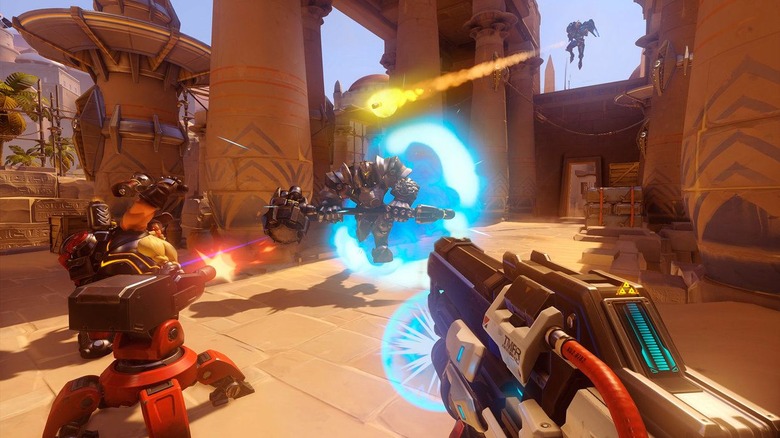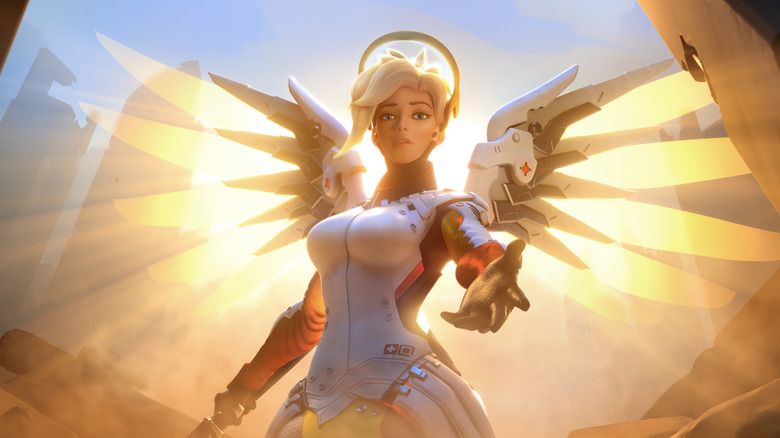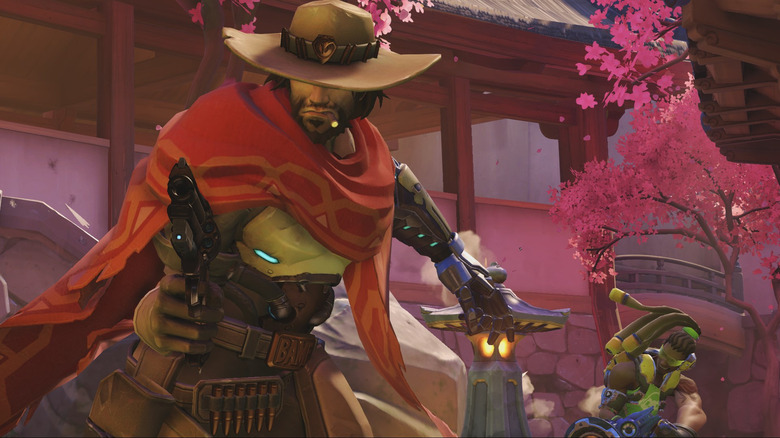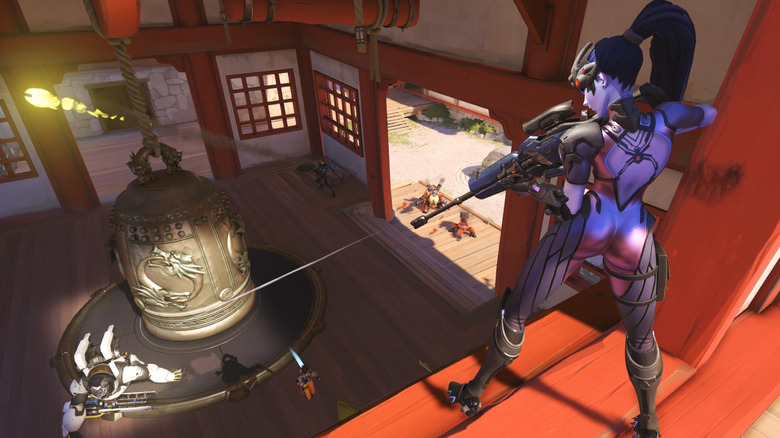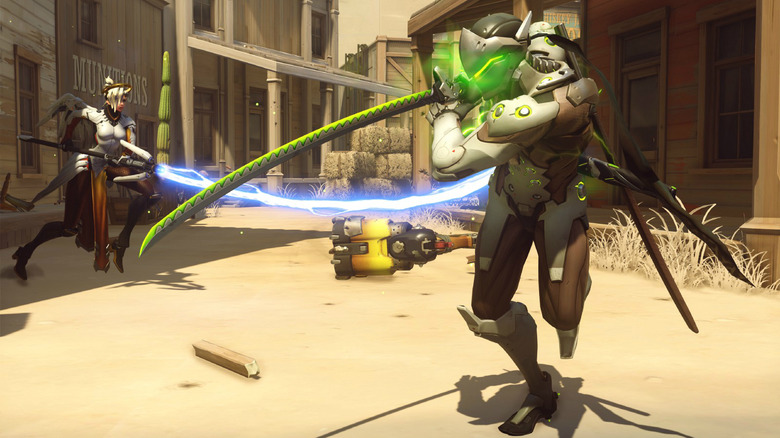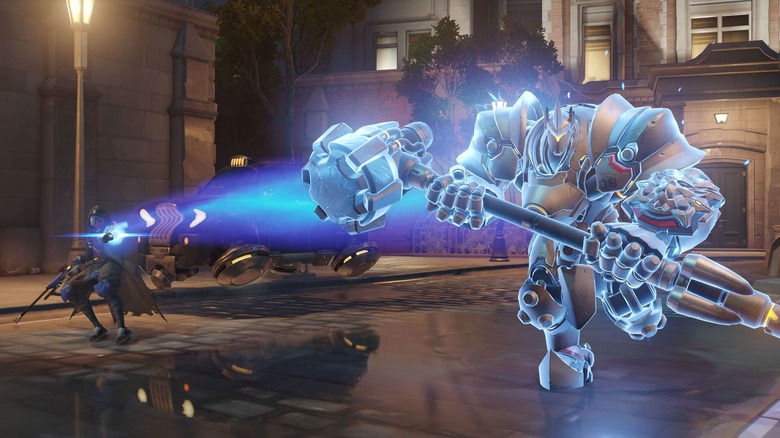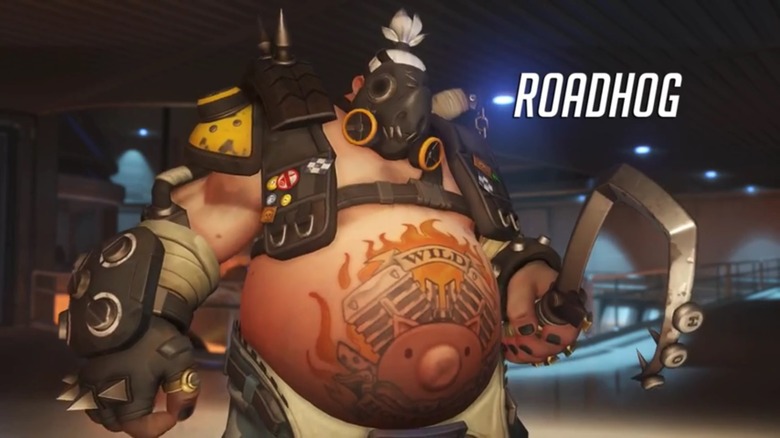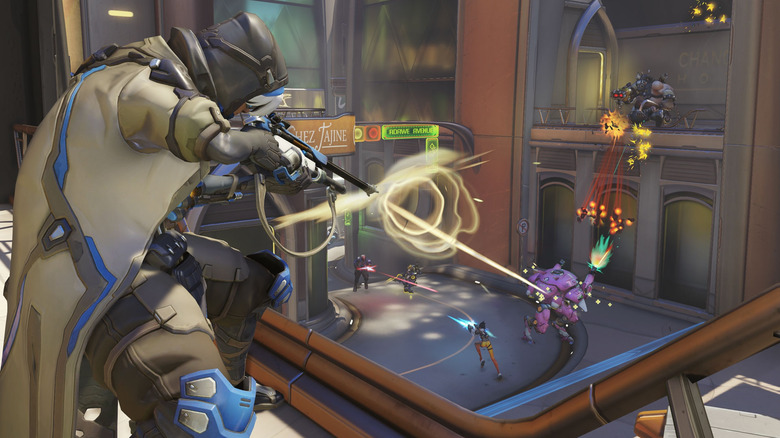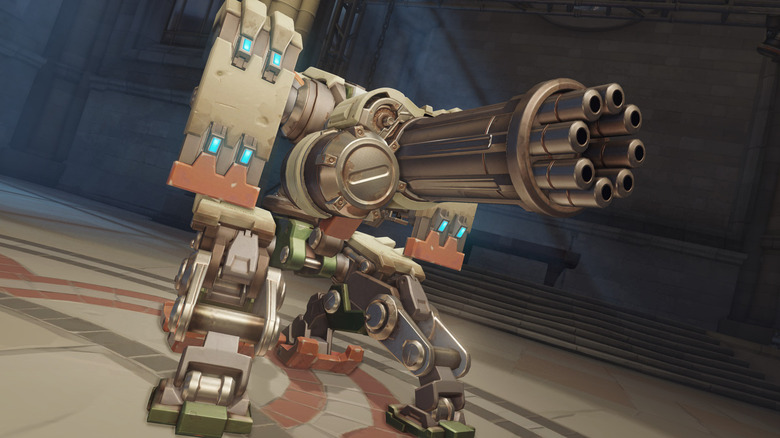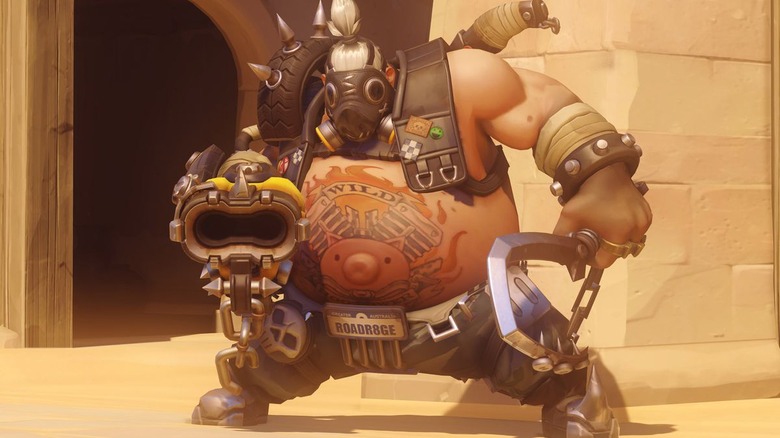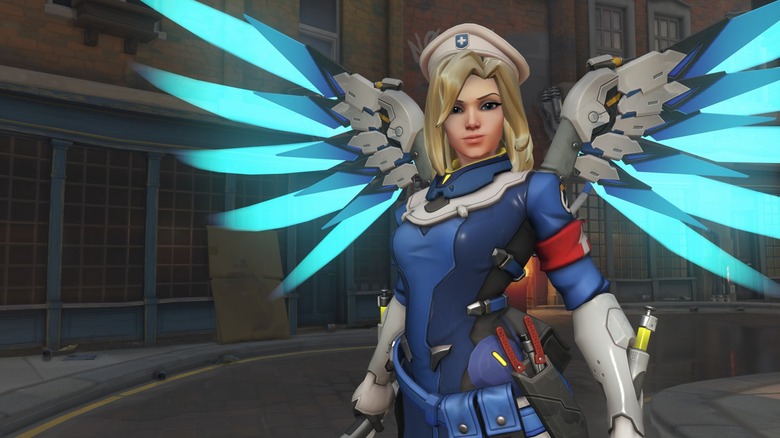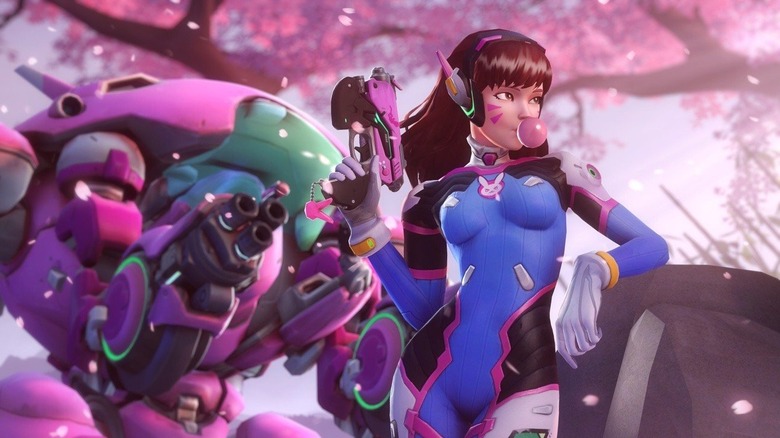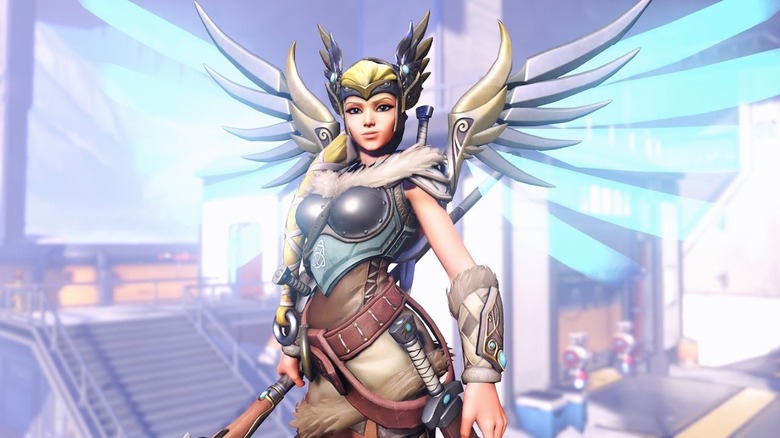Nerfs That Completely Changed Overwatch Characters
Competitive multiplayer games are a constant balancing act for developers. Getting people to play characters requires making them impactful, but pushing a character's abilities too hard can result in an overpowered threat to the health of the game. Weakening characters as a preemptive measure can often dull that hero's debut. Ultimately, though, it seems as though many titles operate under the philosophy of powerful additions first, nerfs (if necessary) later.
Overwatch, for all of its success, has not been immune to periods of balance issues. There have been some incredibly powerful characters in Overwatch's history, and with no other option, Blizzard has had to frequently nerf their effectiveness. Sometimes, a character still plays similarly after a nerf. That doesn't always happen, though, and we've got the data to prove it. Here's our list of nerfs that completely changed the way an Overwatch character was played.
Mercy's Ultimate narrows down
Overwatch's beta was a predictably turbulent time in the game's development. One character in particular underwent a change that completely altered the course of Overwatch history. Mercy actually received four buffs in the February 9, 2016 beta patch: Guardian Angel could now target the souls of dead allies, her activation time and cost on her Resurrect Ultimate were decreased, and Resurrect no longer locked Mercy's aim while it was active. All of this was done preemptively, however, because Blizzard felt the need to overcompensate for what remains one of the biggest nerfs in Overwatch: Mercy's Resurrect received a range decrease, down to 15 meters from its previous 40.
Mathematically speaking, the total area of Mercy's Resurrect had just been reduced to a mere 14% of what it used to be. Mercy now had to be close to fallen allies to Resurrect them, exposing her to potential danger as a squishy unit. Before the change, Mercy players could just wait out team fights at a safe distance and hit a big Resurrect without much worry.
This change would also push Mercy players to use her abilities much more tactically. Despite the massive change, more nerfs would eventually be needed before that philosophy became reality. At the very least, though, this patch changed Mercy into a viable support instead of a must-include in team compositions.
McCree fanned his hammer too hard
While Blizzard is much better at creating heroes with specific roles now, that hasn't always been the case in Overwatch. Some characters early on were a little too flexible in their utility, and a few of them bordered on being far too good because of it.
If any of them were too good, though, it was likely McCree. McCree was a nightmare in early Overwatch, occupying the role of a pseudo-sniper thanks to his range, while also very good at dismantling tank compositions with his Fan the Hammer attack. His flexibility was completely unlike any other character.
McCree's long distance damage was quickly addressed and didn't make it to Overwatch's full release. However, his ability to quickly burst down tanks and unshielded characters on top of the squishies he was supposed to counter was something that needed work. McCree often outperformed Reaper in dealing with tanks. Reaper was designed to be efficient in that regard while McCree was not; there was obviously a problem.
Blizzard addressed this by changing McCree's bullet damage from Fan the Hammer down to 45 from 70. Essentially, that ability now dealt 270 damage to heroes, which was more than enough to deal with opposing Genjis, Tracers, or other high-mobility but squishy heroes. But Fan the Hammer no longer took out tanks like Reinhardt, which made tanks as a whole much more viable in Overwatch. This patch helped balance the game and helped make playing McCree a more skill-intensive and interesting affair.
Widowmaker learns to slowscope
The June 14, 2016 patch in Overwatch was significant because it helped shape the way DPS characters functioned in-game. McCree's changes made sure that he was a close range punisher with some added utility in other situations. Widowmaker, on the other hand, became the model for what long-distance DPS in Overwatch was supposed to look like. All it took were two major nerfs to get there.
Widowmaker's early dominance of Overwatch was linked to her body shot damage, would could get hero kills fairly easily even without needing the headshot bonus. On top of that, Widowmaker also had an animation canceling trick that players had discovered to shorten her reload time. The cancel could be easily achieved by aiming down the sights of Widowmaker's scope, letting go of the scope button, then scoping back in immediately. This would glitch the animation such that players could skip the half-second recovery time associated with Widowmaker's scope outs.
The patch sorted out Widowmaker's balance issues pretty efficiently, though. Widowmaker's scoped shot base damage became 12 instead of 15, which reduced the effectiveness of body shots. Her scoping animation was also changed to force players to wait through it, which basically functioned like a reduction on her rate of fire as well. Widowmaker went from overpowered to a solid damage-dealer over the span of a single day, and Overwatch moved on, better for it.
Genji gets less mobile
Genji is a character that has historically teetered on the edge of needing a nerf for much of his existence. That comes down to his playstyle. When Genji is very good, it can feel like he's doing too much for one character thanks to his combination of speed and damage. As a result, he's received a fair number of tweaks over his time in Overwatch.
Early into the game's existence, though, Genji received a set of nerfs that drastically changed the way players approach him. Before the September 1, 2016 patch, players had begun to unite in their hatred of Genji's ridiculous mobility and overpowered Ultimate. Blizzard addressed this by altering Wall Climb and Swift Strike. Previously, Genji could use Wall Climb to reset his Double Jump, and his Swift Strike could move through Junkrat's Steel Trap and Widowmaker's Venom Mine.
After the patch, though, Genji's insufferable reign as the king of escapes was over. Genji could no longer reset Double Jump after Wall Climb, which meant players couldn't dash away from attacks with the same consistency. The biggest change, though, was to his Ultimate attack Dragonblade. Dragonblade was reduced from an eight-second duration to six, and the two seconds made a huge difference. Genji players suddenly needed to pick their spots, as they didn't have the luxury of a long duration to make up for popping Dragonblade too early.
Ana couldn't spin a top anymore
Ana's debut in Overwatch was exciting because she represented an entirely new take on the support class, operating at a longer distance and providing utility in places that were previously kept separate from supports. Her unique character design wasn't just interesting, though. It caused some serious problems for developers as players began to understand which compositions let Ana shine.
In November 15, 2016, a patch was released that ended the notorious "Reaper Beyblade Meta." For those unfamiliar with it, Reaper Beyblade featured Ana using her Nano Boost to up Reaper's movement while he cast his Ultimate, creating the illusion of a spinning top that brought death wherever it spun. It was cute for a while before it started to dominate Overwatch's online play.
The patch removed the movement buff from Nano Boost entirely. Beyond just ending Reaper Beyblade, it also meant Ana was no longer an automatic choice for people using Reinhardt. Nano Boost no longer made players feel temporarily invulnerable thanks to damage reduction and speed increases, the latter of which had made players harder to hit. Ana had to wait a while before she became relevant again, but her return to the competitive scene came in a big way just a few months later.
Roadhog had to learn some skill
Roadhog is a little different from the other characters discussed so far. When the January 24, 2017 patch hit, it didn't come at a time when Roadhog was far and away one of the best characters in the game. Roadhog had often found himself in a niche role in Overwatch, and many people who mained the character were perfectly content with him remaining an offbeat choice for online play.
This patch introduced Chain Hook 2.0, however, and Roadhog was suddenly nerfed into oblivion. Hook 1.0 was an admittedly broken ability, as it allowed Roadhog to grab people through walls and obstacles, dragging them across the map to his position. Hook 2.0 was changed to use line of sight checks done from Roadhog's position rather than from the hook's position.
Roadhog could no longer just toss out a chain and hope to grab someone. Chain Hook became difficult to use, especially since the patch also introduced interruptions to the ability should the targeted player leave Roadhog's line of sight. Interestingly, Hook 2.0 was initially embraced as a welcome change to the character that would ultimately improve his viability. That didn't come to pass, though, and one of the biggest appeals to playing Roadhog was suddenly gone, leaving many to relearn the character without his most fun ability.
Ana stopped her nade spam
It didn't take very long for Ana to need another nerf after her previously dominant Nano Boost play had been addressed. Just three months later, Ana was the centerpiece of another dominant meta strategy, and this time it was one that had completely slowed the game down.
Ana's Biotic Grenade ability allowed her to occupy the role of an off-healer that could still completely heal a tank in seconds. That's a broken interaction in a game like Overwatch, which is explicitly designed to have jack-of-all-trades heroes be less efficient than their dedicated counterparts. Biotic Grenade allowed team compositions to begin to run three tanks who made up for their diminished damage output by, well, never dying. Teams were gradually broken down and ground to dust under the relentless onslaught of what became known as the "Triple Tank Meta."
When the strategy threatened to smother competitive play, though, Blizzard stepped in with a January 24, 2017 patch that ended its stay at the top. Biotic Grenade was nerfed, reducing the healing boost to 50% down from 100% and scaling back the effect duration by one second. The nerf helped quell concerns over the tank meta and helped the game grow, with Ana once again relegated back to a balanced support rather than the central player in a broken meta.
Bastion was all-powerful -- briefly
Bastion was at the center of one of the shortest-lived metas in Overwatch history. It was a wild time spurred on by the introduction of a brand new ability for the character, and it lasted for around a week before Blizzard had to step in and address the issue.
Bastion received changes to his self-repair and passive abilities in early 2017, receiving an entirely new version of the latter. His new passive was called Ironclad and it reduced the damage he took while in Sentry or Tank mode by 35%. Bastion also became able to self-heal while moving and was no longer interrupted by damage.
Those two abilities combined to make Bastion a suffocating presence in online play. Teams became a bunch of shields and a Bastion parked on the payload. Bastion could actually soak up and heal through damage from Genji Blades and Reaper Ultimates during this time, which should give you an idea of just how difficult it was to deal with.
After briefly preaching patience and asking players to adjust and develop new strategies, Blizzard realized the Bastion issue wasn't going to go away. The developer quickly changed Ironclad to reduce incoming damage by 20% instead, and less than a week after Bastion's new passive had been introduced, the end arrived for one of the most frustrating periods of Overwatch play.
Roadhog lost his rhythm
Believe it or not, Roadhog somehow earned another nerf despite remaining a solid character without warping any meta around him. The June 20, 2017 patch once again changed how Roadhog was played, and was met with a large amount of criticism regarding how it affected the character's design.
This patch changed Roadhog's Scrap Gun in a way that made it nearly unrecognizable. Scrap Gun went from a slow rate of fire and high damage to the inverse, and players immediately hated it. Roadhog went from a character that could still use his hook to get players close and punish them with a high-damage shot or two from the Scrap Gun to a character that just felt like he had no rhythm.
Roadhog had been one of the slower, higher-damage characters in Overwatch up until this point. Scrap Gun played into that mindset, and made Roadhog a character that many people felt was extremely strong in 1v1 scenarios. While players would eventually figure out how to play the new Roadhog and adapt, the initial change was an inexplicable nerf to the character that Roadhog mains absolutely loathed.
Mercy's Ultimate was still too good
Mercy might be the most important character to ever grace Overwatch. As she goes, so too does the meta, and when Mercy is in a healthy spot, it has seemed to produce some good competitive environments.
The first of two major nerfs for Mercy in late 2017 and early 2018 saw her Ultimate ability, Resurrect, get completely restructured as an attempt at nerfing the character. Previously, Mercy could dive in with her Ultimate charged and Resurrect her entire team after a lost fight. The biggest issue with this style was that it promoted Mercy players approaching each game in a similar way regardless of context. Big Resurrects rewarded SR bonuses that online players would chase blindly, sometimes popping Resurrects that would set up their team to get immediately killed again while allowing enemy players to farm Ultimate charge. Obviously, a number of game-winning Resurrects also completely swung games for teams that had just been tactically outmatched.
The changes to Mercy made her play quite differently, as Resurrect now targeted single characters instead. Mercy usage wasn't as widespread, and the game felt like it could breathe a little. For a time, team fights looked quite different and the meta felt healthier — that is, until Mercy got figured out again and required another nerf later on.
D.Va was the Dive Meta champion
D.Va was a symptom of a problem that Overwatch was suffering from in September of 2017: the Dive Meta. What had once been regarded as the cure for competitive Overwatch — an answer to the stifling triple tank meta that had dominated in months prior — had now become the problem. The Dive Meta required controlled chaos, as a team composition of traditionally squishy heroes moved in unison to execute powerful abilities and wipe a team at a certain point on the map.
A change to Junkrat in June, however, had inadvertently removed a natural predator of the dive compositions, and soon, dive comps became a plague on the ladder that had extended into lower-tier play. Pretty soon, D.Va became synonymous with diving because of her Defense Matrix ability, which allowed the strategy to be executed much more safely thanks to the brief window D.Va could block projectile attacks.
When the Dive Meta threatened to stifle Overwatch, Blizzard came down on D.Va hard, reducing Defense Matrix's uptime by 50%. The funny thing is, D.Va somehow survived this nerf and remained a consistent presence in competitive play, albeit with a very different angle of attack. The Dive Meta survived as well, which really makes you wonder why D.Va took the brunt of the punishment for something that could exist without her quite easily.
Mercy's Resurrect finally got balanced
Mercy was up to her old tricks prior to the January 30, 2018 Overwatch patch. It took people a little bit of time and testing, but Mercy's recently changed Resurrect once again dominated team fights in competitive play. Teams knew that they could aggressively take small skirmishes because Mercy's Resurrect, when managed properly, would be available at most critical junctures. Mercy's nerfs regarding this new meta actually took Blizzard two tries.
The first nerf tried to punish Mercy for going for risky resurrects, making her wait 1.75 seconds to cast it while also reducing her movement speed and making interrupts possible. Unfortunately, Blizzard also buffed Mercy's new Ultimate, Valkyrie, too much in the same patch. Valkyrie allowed players to ignore Resurrect's cooldown time and to ignore the speed reduction casting Resurrect would cause.
Finally, about six months after the massive changes to Mercy first happened, Mercy received a nerf that removed all the benefits that Resurrect got during Valkyrie. This ended the Mercy meta at long, long last.

